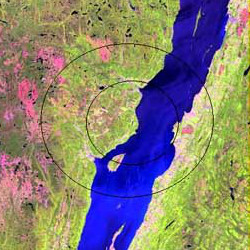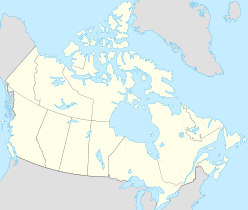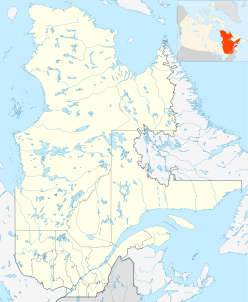Charlevoix crater facts for kids

Landsat image of the crater. The inner circle marks an early estimate of the diameter; the outer circle indicates a more recent size estimate
|
|
| Impact crater/structure | |
|---|---|
| Confidence | Confirmed |
| Diameter | 54 km (34 mi) |
| Age | 450 ± 20 Ma Ordovician to Silurian age |
| Exposed | Yes |
| Drilled | Yes |
| Bolide type | Stony meteorite |
| Location | |
| Coordinates | 47°32′N 70°18′W / 47.533°N 70.300°W |
| Country | Canada |
| State | Quebec |
| Municipality | Charlevoix |
The Charlevoix impact structure is a huge area in Quebec, Canada, that was formed by a meteorite hitting Earth. It's like a giant, ancient scar on the land. Part of this impact area is visible on the surface. The rest is hidden beneath the Saint Lawrence River.
Contents
What is the Charlevoix Impact Structure?
This impact structure is a very old and large crater left by a meteorite. Scientists believe it was originally about 54 kilometers (34 miles) wide. The impact happened around 450 million years ago. This was during the Ordovician and Silurian periods, a time when Earth was very different.
The Meteorite That Hit Earth
The space rock that caused this huge impact was probably a stony meteorite. It was likely at least 2 kilometers (1.2 miles) across. Imagine a rock that big! It weighed an incredible 15 billion tonnes. When it crashed, it created an enormous hole in the ground.
How the Crater Formed
When a very large meteorite hits Earth, it doesn't just make a simple bowl-shaped hole. The impact is so powerful that the ground acts like a liquid for a moment. This causes the center of the crater to bounce back up. This "bounce back" forms a central peak. In the Charlevoix structure, a mountain called Mont des Éboulements is the central peak. This type of crater is called a multi-ringed basin with a central uplift.
How Do We Know It's an Impact Crater?
Scientists first realized Charlevoix was an impact crater in 1965. They found special rocks called shatter cones in the area. These cone-shaped rocks only form under the extreme pressure of a meteorite impact.
Other Clues from Rocks
More proof came from tiny features found in quartz and feldspar grains. These are called planar deformation features (PDFs). They are like microscopic cracks or lines in the minerals. These features also form only when rocks are hit with incredible force, like during a meteorite impact.
Life Inside the Crater
The Charlevoix impact structure looks different from the rugged Laurentian Mountains around it. The impact area is much smoother and flatter. This made it a good place for people to settle. Today, most of the people living in the Charlevoix region (about 90%) live within this ancient impact structure.



